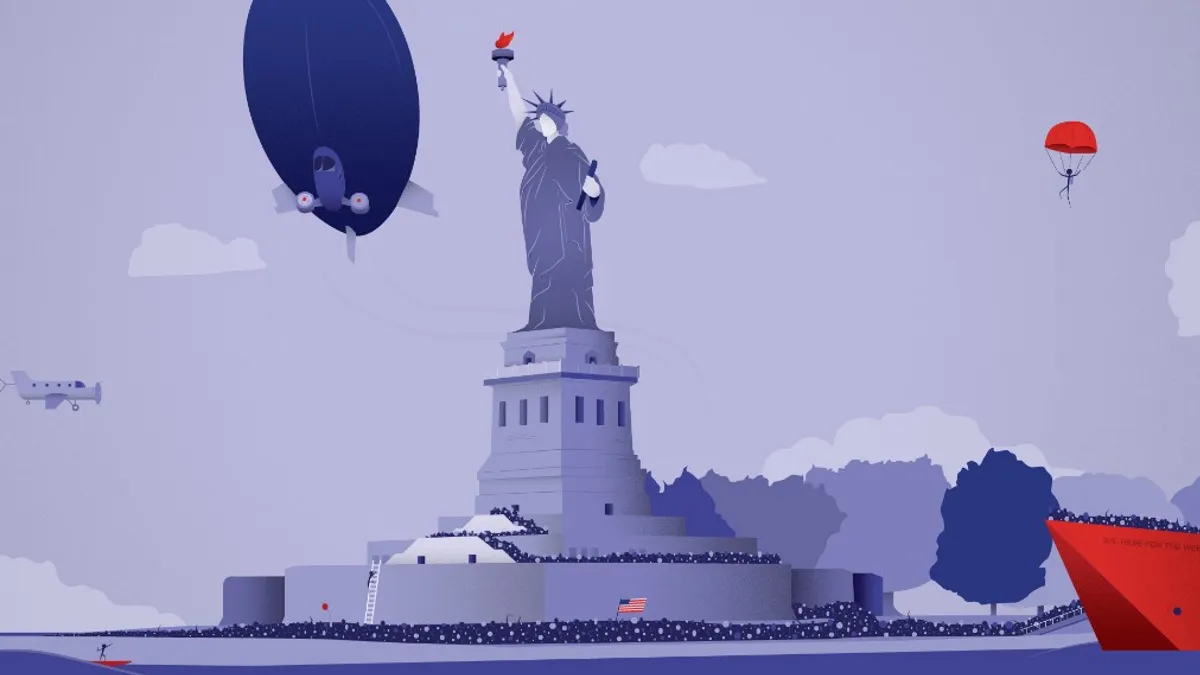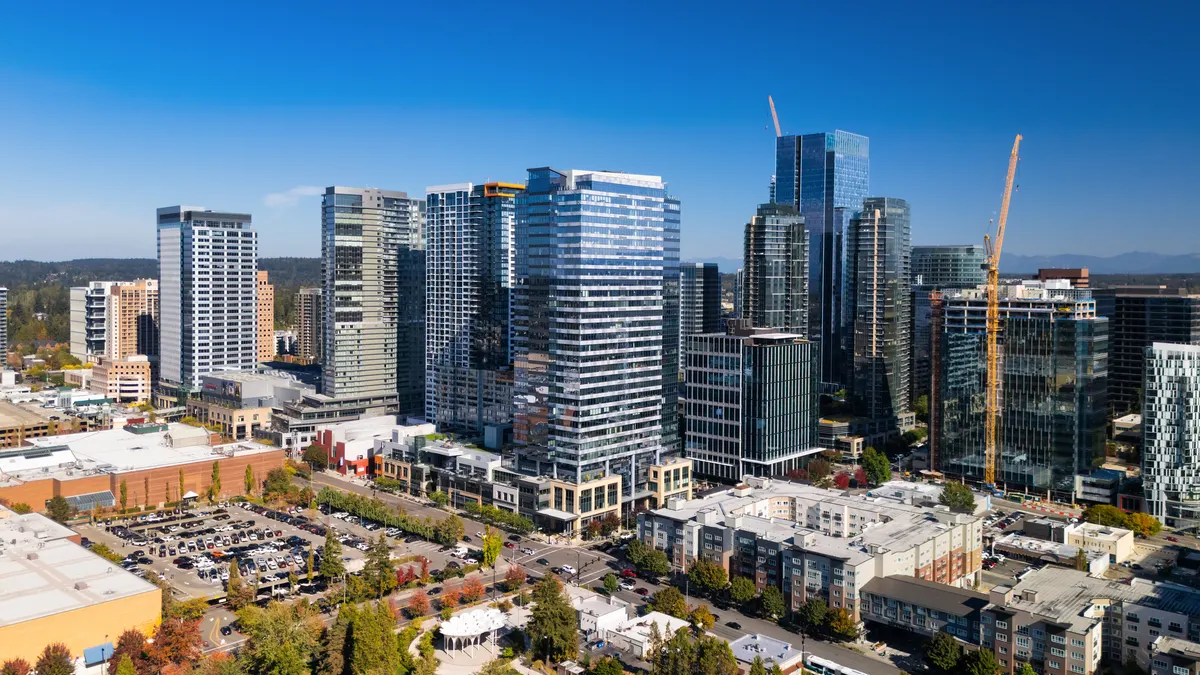New York City's Restaurant Week is a call to foodies near and far to travel to the city and feast on lamb ragout and goat cheese at rustic Italian eateries like Maiella in Queens, overlooking the Manhattan skyline through the building's iconic Pepsi-Cola sign. Diners can also travel to Brooklyn's Carroll Gardens neighborhood and stuff themselves on buttermilk fried chicken, cheddar waffles and slices of blueberry pie.
On its face, the 27-year-old event, which kicked off in July, provides visitors and residents with delicious meals, discounts and Instagrammable moments. But the initiative does something arguably more important. It provides visitors with a literal taste of the city's five boroughs, enticing tourists to travel throughout New York instead of overcrowding just one area.
The event is one of many initiatives helping the city manage visitors and prevent a phenomenon cropping up across the globe: overtourism.
It's a trend that has captured the world's attention this year. In Paris, the Louvre shut down due to a staff strikes over dwindling conditions following a record-breaking 10.2 million visits last year — a 25% increase compared to the year prior. Amsterdam rolled out an "Enjoy & Respect" campaign to battle tourists' bad behavior, involving loud singing, littering and public urination. And in Barcelona, the mayor pledged to reduce the number of cruise ships infiltrating the city's ports, recently declared the continent's most polluted.
Horror stories about overtourism in Europe have served as cautionary tales for U.S. cities.
"European cities have been sort of the canary in the coalmine for what we’re beginning to see here in the U.S.," Martha Honey, executive director of The Center for Responsible Travel (CREST), told Smart Cities Dive.
But despite the negative side effects of overtourism, the benefits of tourism remain indisputable. The travel and tourism sector accounted for 10.4% of global GDP last year, creating one in five jobs globally — jobs that can't be outsourced and transferred to other countries. And the industry shows no signs of stopping. It's expected to continue growing rapidly, outpacing the growth of the economy, Gordon Innes, senior lead of the Bloomberg Associates economic development practice, told Smart Cities Dive.
The tension between the economic upsides of heavy tourism and its negative side effects begs the question: How can cities reap the benefits of tourism in a responsible and sustainable way?
The perfect storm
To start, cities need to redefine how they measure tourism success, according to Honey.
Overtourism has become a widespread phenomena in part because tourism "success" has been defined by the number of visitors brought to a destination. That definition has helped drive some of the key factors causing overtourism: an explosion of Airbnb rentals and cruise-tourism; a rise in the middle class; the infiltration of social media; and cheap air travel. This combination has created "the perfect storm" within the past five to six years, according to Honey.
Tourism ministers and departments need a new definition of "success." They should measure the quality of tourists rather than the quantity, and shift from a marketing to a management approach, she said.
The World Travel & Tourism Council (WTTC) and commercial real estate firm JLL released a report in June with their first assessment of cities' preparedness for tourism growth. The report, "Destination 2030: Global Cities' Readiness for Tourism Growth," identified just how ready cities are for the industry's rapid growth.
Tourism can only thrive when cities achieve the right balance between private, public, community and business, WTTC Vice President of Research and Insight Rochelle Turner wrote to Smart Cities Dive.
"All cities need to ensure that travel and tourism is fully integrated into their overall urban plans," she said. "From transportation to way-finding and zoning, if the systems are not built to cope with tourism demand on top of residential and business demand, then cities can find themselves in difficulty. This planning for tourism needs to go right to the heart of city governance, take a long term vision, involve stakeholders and be properly funded."
How the Big Apple prevents overcrowding
U.S. cities like San Francisco and New York fared well in the report.
"This planning for tourism needs to go right to the heart of city governance, take a long term vision, involve stakeholders and be properly funded."

Rochelle Turner
WTTC Vice President of Research
New York City was categorized as a "mature performer," meaning the city has a strong leisure and/or business travel dynamic and established tourism infrastructure. But there's still a risk that future strains might test the city’s ability to handle growth.
The city’s preparedness was already tested in a major way this year. A rise in tour groups overwhelmed two of the city's iconic attractions, The Statue of Liberty and the Ellis Island National Museum of Immigration. The sites receive 4.5 million combined visitors per year. To deal with growing congestion (and to put an end to some bad behavior), officials banned commercial tour guides from areas of the sites this May.
Such bans will help the city prevent overcrowding at popular attractions, but there's no stopping the increasing rate of visitors to the city overall.
In 2018, New York City welcomed 65.1 million visitors, according to Nancy Mammana, chief marketing officer of NYC & Company, the city's destination marketing organization and convention visitors bureau.
To keep up with those numbers, NYC & Company works to disperse travelers throughout the five boroughs, preventing gridlocks and enticing visitors to travel during shoulder seasons.
To avoid "choke points" or overcrowding in one area, the group moves visitors throughout the city with campaigns like restaurant week. NYC & Company's contract with the city mandates that they spread economic prosperity throughout the five boroughs, Mammana said. It's an approach that has been built into their DNA from the beginning.
The group also encourages tourists to visit during less popular seasons with campaigns like "NYC Winter Outing." The initiative helps residents and tourists overcome the classic winter case of "FOGO" (fear of going out) by enticing people to turn off Netflix and explore the city during the chilly off-season with deals on restaurants and Broadway shows.
Lessons learned in the golden state
San Francisco, home to the world's most crooked street, the Golden Gate bridge, and "Karl" the Fog, ranked as "managing momentum" in the WTTC and JLL report. The category indicates that San Francisco, along with Amsterdam and Barcelona, have high visitor volumes that could cause future strains.
Lombard Street, the redbrick crooked road in the Russian Hill neighborhood, flanked by shrubs, plush-toned flowers and steep stairways, is one such site that has become all too inviting for visitors. The site attracts two million visitors annually and has up to 10-hour-long queuing on a daily basis. The popular attraction has become a major headache for local residents trying to get around in their own neighborhood, according to San Francisco Travel Association President and CEO Joe D'Alessandro.
He said the travel association is working with the city to reduce congestion to potentially require that tourists make reservations in advance or pay a small fee, two tactics likely to become more common as cities across the U.S. battle congestion.
The crowding at Lombard Street is just one example of the need for destination marketing groups to evolve their roles and definition of tourism "success."
"We're known as destination marketing organizations, but I think we also have to be destination management organizations," he said.
The most magical (and data-driven) place on earth
Cities can also look to a fictional world for help.
Walt Disney World Resort's "MagicBand," a wristband complete with a Mickey Mouse silhouette, custom colors and name engravings, illustrates how cities could use data and analytics to manage the flow of visitors. The wristband covers all the digital essentials of an individual's visit: passes, photos, credit card information and even room "keys".
The technology powering the private sector will soon make it ways to the public, Bloomberg Associates' Innes said. "There's also a lot of cities that are now starting to think about how they can use big data and analytics and really good insights into their audiences to get them to travel at different times."
More cities will be able to use data and analytics to understand where tourists travel; how long they spend in different areas; and where they're spending money. Those insights can be linked to dynamic CRM tools to help engage tourists in real-time, communicating different areas they can travel based on the individual's specific needs and wants, according to Innes.
Insights from advanced technology can also support an old-school solution to over-tourism: staying longer and slowing down.
It's better for the destination and the tourist's carbon footprint to travel to one destination, remain for a good amount of time and get to know the area, according to Honey. Longer visits help ensure that local businesses are patronized, builds respect among the traveler and — despite Disney's other benefits — prevents a "Disneyland effect" where generic trinkets are sold rather than authentic goods original to the area, she said.
Time to redefine "success"
Ultimately, tourism doesn't show any signs of slowing down. But that doesn’t mean cities and destination marketing groups need to cut back on their number of visitors.
"I don't think it's about getting fewer tourists," Innes said. "It's about getting higher quality tourists who come at different times of the year and dispersing them time wise as well as geographically."
A slower approach to travel paired with initiatives like data-driven techniques, dispersing travelers throughout the city and encouraging off-season visits, can help cities get ahead of the curve by managing tourists and preventing overcrowding.
Because when it comes to stopping overtourism in its tracks, it's best to be proactive rather than starting when it's already too late, according to D'Alessandro.





















